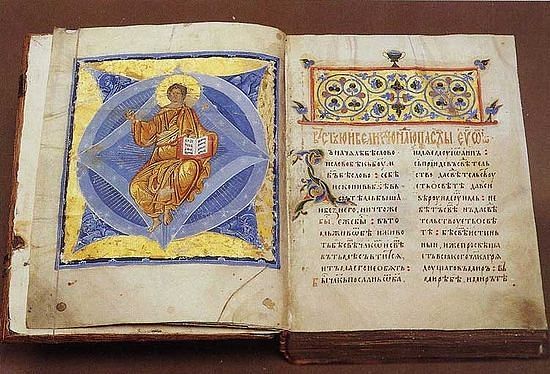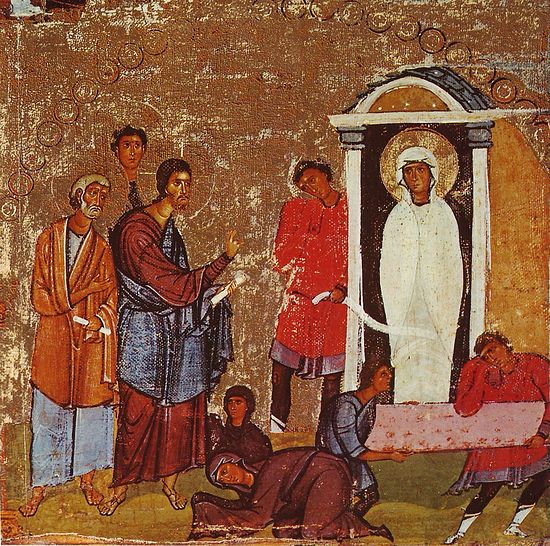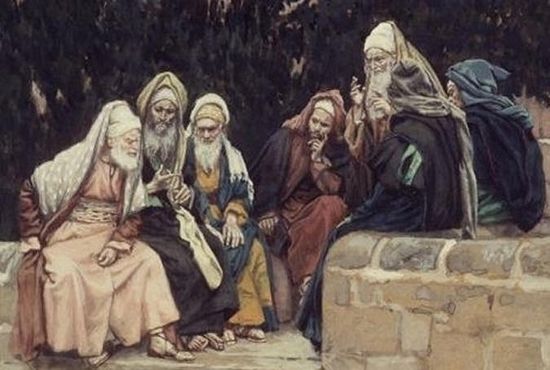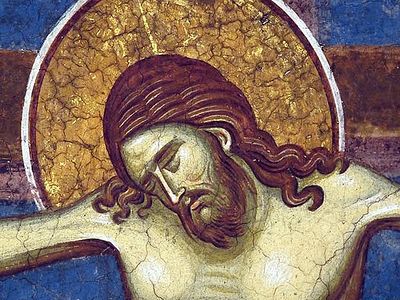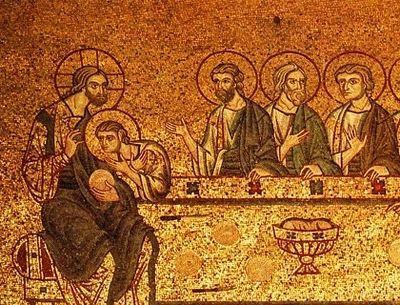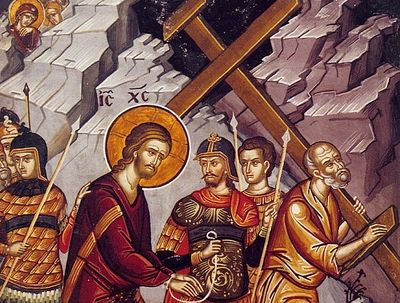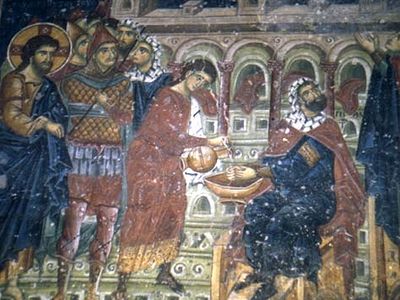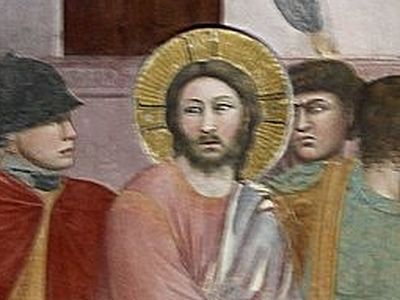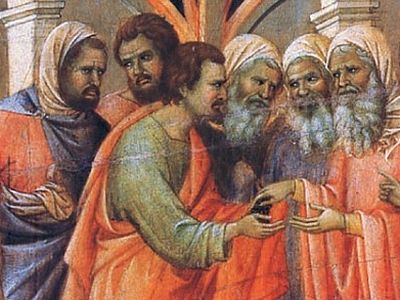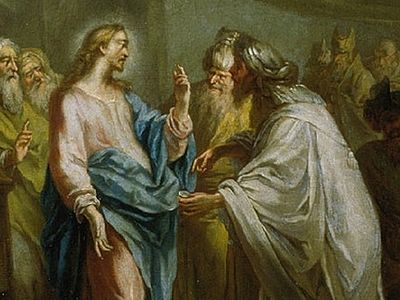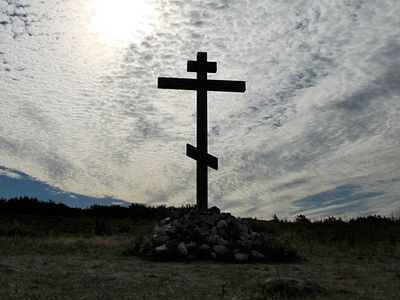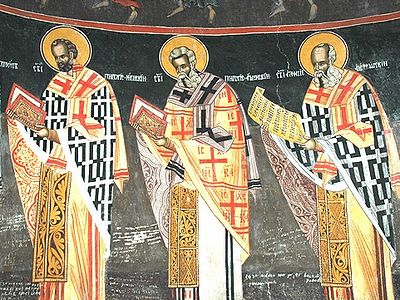See the last podcast: on the holy fathers.
Dr. Jeannie begins her Lenten Bible study podcasts on the Trials and Crucifixion of Christ.
Now we are beginning our study of the Scriptures. Previously I was just teaching you about the Fathers, but now we’re going to be beginning an actual Bible study. I would like to start and end each lesson with a prayer. The opening prayer that I have used for years and years is from the Divine Liturgy of St. John Chrysostom—it is a prayer before the reading of the Gospel. It is one of these so called “inaudible” prayers, one which the priest says silently or quietly, but it is so beautiful and so appropriate for Bible study. I hope you will learn it by heart. Frankly, I think it is appropriate for many occasions because it talks about following the Gospel commandments and thinking and doing things that are well-pleasing to the Lord; so it really fits many, many occasions, and not just the study of the Bible. I will say this prayer every time I open the podcast and I hope that over time you will also learn it by heart, just by listening to the program.
You may also already know the closing prayer from the services of the Church. It comes from the Gospel of Luke, and it is the prayer of St. Simeon. It is the traditional prayer that is said upon departure from the church, or a church service, and I used it to close the Bible studies when we would meet on weeknights and our time together was ending, our fellowship was ending and we were leaving the church. I would close with this prayer. Thus, I would like to end with this prayer every time, even though we’re not around the table in the same room at the same time.
Now let’s begin with the opening prayer: “In the name of the Father, and of the Son, and of the Holy Spirit. Amen. Illumine our hearts, O Master who loves mankind, with the pure light of Thy divine knowledge, and open the eyes of our mind to understand Thy Gospel teachings. Implant in us also the fear of Thy blessed commandments, that trampling all carnal desires we may enter upon a spiritual manner of living, both thinking and doing such things that are well pleasing to thee. For Thou art the illumination of our souls and bodies, O Christ our God, and to Thee we ascribe glory, together with Thy Father Who is from everlasting, and Thine all Holy and Good and Life-giving Spirit, now and ever and unto the ages of ages. Amen.”
Isn’t that a wonderful prayer? Don’t you see how it suits so many occasions, and not just the study of the Bible?
Anyhow, let’s start talking about the trials and Crucifixion of the Lord. I say “trials” because there was more than one. There was a Jewish trial and a Roman trial, and we will be talking about both of them. As you know, the Triodion prepares us for Lent, and Lent prepares us for Holy Week. The earlier services of Holy Week prepare us for the later services, for Great and Holy Friday, the Crucifixion and the Resurrection. You see, the Church was very, very wise. The Church always understood that we can’t just be plopped from Palm Sunday straight into Great Friday. That’s not realistic. We have to understand what was happening. We have to be prepared spiritually, mentally, emotionally. So the Church has always put these events into context.
Pastors love to say how the Lord was acclaimed by the crowds on Palm Sunday and then on Great Friday the crowd shouted, “Crucify Him! Crucify Him!” You know, that doesn’t make sense, and in fact that really didn’t happen. They were not the same people on Palm Sunday who were saying “hail” to the Messiah, “Hosanna” to the Messiah, who then on Friday were shouting, “Crucify Him!” We’ll talk about that when we get to it. But the point is, we can’t make a leap from one to the other. We have to understand things in their historical context. So the early services in Holy Week help us to understand why the Jews wanted to crucify Christ. They show us, the readings show us the growing tensions between the Lord and the Jewish leaders. Now I hope you intend to go to all the services of Holy Week and not just go to church on Palm Sunday, then pick up maybe again on Great and Holy Thursday, but certainly on Great Friday. I hope you intend to go to all of the church services of Holy Week and that you will have a Holy Week service book to follow along with the church services. This is very important. Find out which book your priest or your parish uses if you don’t already have one so you can follow along—not only with the readings, but with the hymns of the Church; because the hymns help us to understand the readings.
Life in first-century Palestine
The truth is that we don’t really understand very much about life in first-century Palestine, and so we cannot appreciate all of the details in the Gospel stories; but at the same time, ironically, these stories are so familiar to us that in many ways they have ceased to have an impact on us. So, I hope that this series will help you to understand what happened from a historical perspective, so that the Gospels will become alive for you during Holy Week and that you will understand them in a deeper way. Thus, we’re going to begin by explaining what first century Judaism was like. This is Biblical Judaism, this is Judaism which is very different from the Judaism of today.
Now most of you know that today there are three basic ways to be a Jew. You have Orthodox, Conservative and Reformed Judaism. Now you might notice that these are not the names of the groups that you hear about in the Gospels, isn’t that right? We don’t hear about Orthodox Jews and Conservative or the Reformed Jews in the Gospels. Who do we hear about? We hear about the Pharisees, the Sadducees and the scribes, etc. Those are the groups we’re going to talk about in our Bible study today. So in first century Judaism, there was a very wide variety of ways to be Jewish.
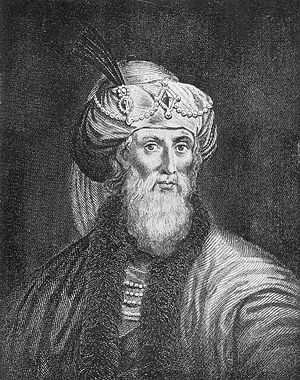 The romanticized woodcut engraving of Flavius Josephus appearing in William Whiston's translation of his works. Photo: Wikipedia
The romanticized woodcut engraving of Flavius Josephus appearing in William Whiston's translation of his works. Photo: Wikipedia
Why Christ was so controversial
Now the Lord was very controversial. We don’t think of Him as controversial. We’re used to His teachings, but even now it is fair to say that Christ was controversial. His message demands a response. Now as for most of the Jewish leaders, they had to respond or not respond. Much of the theme of the Gospel of John is about the message of Christ and the requirement of response: faith or unbelief. The Jewish leaders generally responded negatively, because the Lord challenged the status quo; He challenged the norms of the religious establishment, the standards of what it meant to be a good Jew. He offended a lot of people, and I think it’s important to remember this, because sometimes we think that we are being Christ-like while saying nothing when people are doing evil things. Now it is Christ-like to say nothing when we are being persecuted personally, but when we see other people doing harm to other individuals, not ourselves, it’s not right to be silent just because we don’t want to hurt anyone’s feelings or offend anyone. Yes, the Lord was meek and He was humble. He allowed Himself to be persecuted, but He stood for what was right. He always spoke the truth and this is why he caused offense. And I think it is not incorrect for us to speak up and say the truth when it is necessary to do so.
Now, the efforts to end the life of the Lord began from day one. This is something to remember. We don’t think about it, but we see this consistently in the Gospels. Actually, in the Gospel of Luke we see that the very first time He preached was in the synagogue of his hometown of Nazareth, and on that occasion he read from the book of Isaiah. He commented on it and His remarks were so offensive to the people that they wanted to kill him right there and then. They wanted to throw Him off a hill it says, meaning, throw Him off a cliff. But we see the same thing very early in the Gospel of Mark and in Matthew—not that specific incident in the synagogue in Nazareth, but we see early in the ministry of the Lord when he was up in Galilee that there were many people who wanted to arrest Him and kill Him.
But the single most important event that triggered the decision to put Him to death immediately, that is, before the Passover, was the raising of Lazarus. Isn’t it interesting how the Church puts that into historical context for us? Where do we see the raising of Lazarus? Where is that found? You should know this. It is in the Gospel of John and only in the Gospel of John, but it is such an important story because it tells us why they were motivated to put Him to death so quickly. It is not so much that they wanted to put him to death for the raising of Lazarus, but the raising of Lazarus is what triggers the great crowds to come out on Palm Sunday to hail the Lord as the Messiah. They heard about what had happened because Lazarus lived in Bethany only two miles outside of Jerusalem; and the story tells us that when Lazarus was raised, there were many people there from Jerusalem who witnessed it. They went back to Jerusalem. They told people what had happened. So the next day, when the Lord entered Jerusalem, He was acclaimed and proclaimed as Messiah and the king of Israel. This is what St. John reports. So, the Jewish leaders saw how the crowd was proclaiming Him as the Messiah (this is what it meant to hold palm branches and spread out your cloaks and say, “Hosanna, Son of David!” This is what it meant. You’re proclaiming that He is the Messiah.) Well, when the Jewish leaders saw this, they resolved to put Him to death before the Passover. This is the trigger event. So there were lots of efforts to kill Him, to arrest Him, lots of plans, but this is the thing that makes them decide that he must be put to death immediately.
Do you see how the Church tries to put this in context for us? Now we’re going to talk about each of the various groups of Jews in turn, but before we talk about them we have to know about a couple of things that were absolutely fundamental to Jewish life during the era of Biblical Judaism, and also some that are still important today. First of all, the Law of Moses. What is the Law of Moses? Some people think that this refers to the Ten Commandments, but when the Bible is talking about “the Law,” it’s not talking about the Ten Commandments. The Law of Moses was a whole series of rules that governed Jewish life, and they still govern the life of observant Jews. The Bible has about 613 rules or regulations that covers all kinds of things. There are rules against tattoos, there are rules about how you wear your hair and how to dress; about tithing, fasting, ritual washing, what you can eat, where you can eat, with whom you can associate, Sabbath regulations, dietary laws, etc. These are in the Bible itself, the first five books of Moses, the Torah, or Genesis, Exodus, Leviticus, Numbers and Deuteronomy. There are Laws that tell you how you must live your life. Now they talk about ritual cleanliness. There’s a difference between physical cleanliness and ritual cleanliness. So, when the Bible speaks about, or you hear the Lord conversing with the Jews about what is “clean” and “unclean,” they mean ritual cleanliness. So you yourself can be physically clean; you might look very well-groomed and totally clean, but as far as a Jew is concerned, you are defiled, you are ritually unclean because you are not keeping the Law of Moses.
For example, let’s say you eat a cheeseburger. The cheeseburger makes you ritually unclean because you mixed together milk and meat products. That’s forbidden by the Law of Moses. You can’t have meat and milk in the same dish, so that has defiled you, and you are ritually unclean. The fact that you’re a Gentile makes you ritually unclean. There are many Jews who, if they’re law observant Jews, Orthodox Jews, who won’t even set foot in the house of another Jew who is not keeping the Law because they don’t want to be defiled. We see lots of hints of this in the New Testament. So the Law of Moses is extremely important.
The types of Judaism that exist today are basically the same form of Judaism. The difference is whether or not you observe the Law and how strictly you observe it. So Orthodox Jews observe the Law of Moses much more strictly than Reform Jews who may not observe it at all. Conservative Jews are usually somewhere in the middle in terms of how strict they are. So it’s a very fluid thing among the Jews modernly—how much they observe the Law.
Now there is another thing you need to know about first-century Judaism. The Law of Moses still exists, and it is still followed by observant Jews. The thing that does not exist from the first century is the Temple. Now, the Temple was extremely important in Judaism. It was believed that God dwelled among His people in the Temple and it was the assurance of God’s faithfulness to the Covenant. They believed it protected the city. It was located at the highest point in the city of Jerusalem, and it was a huge complex—not just like a modern church. It occupied about 25 percent of the land of the city of Jerusalem, and it was the center of the political, religious and economic life of the nation. Many people, if not most people in the city were dependent upon the Temple for their livelihood. And of course, the Lord prophesized its destruction—and that was considered a very, very serious thing to say.
Today Jews sometimes refer to their synagogue as a temple. Only Reform Jews do this. So you might have a friend who says, “I’m going to temple on Saturday,” or you might drive by a place that is called, “Temple Beth Israel,” or “Temple Beth Shalom.” They are not temples. A temple, the Temple I should say, was the place where animal sacrifice occurred. That was the purpose of the Temple in Jerusalem. A synagogue does not allow animal sacrifice. That doesn’t happen anymore. There was only one Jewish temple at a time. There were only two in the entire history of the world: first, the one that was built by Solomon way back around the year 950 or so B.C. Solomon built the first Temple. It was destroyed by the Babylonians in the year 586 or 587. Then the Jews were taken off into exile. When they returned to Palestine they rebuilt the Temple, which is called the Second Temple. Later—much later, about 500 years later—Herod the Great improved, beautified and enlarged the Second Temple, and so sometimes the Second Temple is called “Herod’s Temple”; but it was not a third Temple, just the Second Temple improved. So in the history of the Jewish people there have only been two Temples. The Second Temple was destroyed by the Romans in the year 70 A.D.
The significance of the Temple
Now the Temple was extremely important, as I said, because it was the only place in the world where animal sacrifice could be performed, and animal sacrifice was required by the Law of Moses. A synagogue was never a place where sacrifice was performed. That was a place where the Jews sang hymns, read the Scripture, heard a sermon, and said prayers. Today, because there is no Jewish Temple, the Jews have only synagogues for worship. That’s why I said before that even if you see a building called “Temple,” it is not a temple because no animal sacrifice is taking place there. The Jews do not have a temple any longer even though they live in the land of Israel, because the Muslims built a mosque on the site of the Temple. And if you see photographs of the city of Jerusalem, and you see a big, gold dome, that is a mosque. That site is the holiest place for the Jewish people. It was the site of the Temple, but the Muslims built a mosque there called the mosque of Omar or the Dome of the Rock; this is the source, the most important source, of all the tension between the Jews and the Muslims. The Jews would love to have the Temple Mount again and be able to rebuild the Temple. Many Jews would want to start the animal sacrifices all over again, which they used to engage in centuries ago. But the point is that nothing remains of the actual Temple today. The Wailing Wall, or the Western Wall, which is the holiest site of Judaism today, is not even a wall of the Temple. It’s a retaining wall for the mountain upon which the Temple once stood. But the point is that the Temple was extremely important in the life of the Jewish people, and we’re going to talk about how the Temple is really the trigger. The first charge, the so-called statement of the destruction of the Temple, is first the charge brought against the Lord at his trial.
So we’ll talk about the Temple again later. Now let’s talk about the different groups. Now that you know about the importance of the Law of Moses and the Temple in the lives of the Jews of the first century, let’s talk about these various groups we hear of: first, the Pharisees. Who were the Pharisees? In a nutshell, they were the people who emphasized the following or the observance of the Law of Moses as strictly as possible. They believed that what made you righteous in the eyes of God, that means, acceptable to God, is that you kept the Law. And the more closely, the more carefully, the more specifically you observed the Law, the better person you were. So they emphasized ritual purity by observing the Law of Moses. The leaders among the Pharisees were the rabbis. “Rabbi” simply means “teacher.” A rabbi is not a Jewish priest. There were Jewish priests at the time, but there aren’t any longer, because there is no Temple.
The Pharisees
Now the genius and importance of the Pharisees is that they adapted the Law of Moses to changing times and circumstances. They developed a very elaborate interpretation of the Law. Remember, I said there were about 613 specific laws in the Bible, but those laws were given to Moses around 1250 B.C. That was a very long time ago. As times changed and circumstances changed, there were many questions that arose, and events, circumstances, situations, as I said, that weren’t covered by those 613 laws. So they elaborated and expanded upon the Laws to create an interpretation of the Law. All of this interpretation was oral and it was known as the “Oral Law,” or the “Tradition of the Elders.” There were thousands of regulations in the Oral Law, and a Pharisee would try to keep all of these rules that governed everything you did in your life from the moment you woke up in the morning to the moment you went to bed, and it was intended to cover a myriad of situations in daily life. The problem was, there were so many rules that it was almost impossible to follow the Law. First of all you didn’t know what all of the rules were because the oral Law wasn’t written down. These rules were oral traditions that the Pharisees had created over the centuries, but they were so technical and there were so many of them, that the Lord called the Law “a burden.” He said, “You lay burdens on men’s backs that you yourselves cannot even carry.” But the Pharisees believed that the complex requirements of the oral Law were just as binding on Jews as the written Law. So there were thousands of rules you had to follow, and of course you had to know them first in order to be able to follow them.
Now the good thing about the Pharisees is that they were adaptable and flexible. This was the only form of Judaism that survived after the destruction of the Temple. Today all Jews are religious descendants of the Pharisees, because Jews worship in synagogues, they emphasize the Law of Moses (to some degree or another, depending on what form of Jew they are), and their leaders are rabbis. So, all forms of modern day Judaism descended from the form of Judaism practiced by the Pharisees. The Pharisees were successful because they survived, because, as I said, they were able to adapt the Law to changing circumstances. How would they adapt the Law? For example, the Law said you cannot light a fire and cook on the Sabbath. That was considered work. Today people don’t generally light fires in order to cook, so what is the modern equivalent? Today they would say the modern equivalent is turning on a stove or an oven. So an observant Jew will not turn on a stove on the Sabbath. They won’t turn on a light switch on the Sabbath, because that is the modern equivalent of what the Law prohibited. So you can see from this that the Pharisees were very flexible and adapted the Law to changing times and circumstances. But by adding rules they made it more and more complex, more and more burdensome.
Now why did they do this? Not because they just wanted to create problems, but because they believed it was their obligation to keep the Law. The Law was given and ordered by God. They wanted to be holy, pure, and acceptable to the Lord through ritual purity. They believed that this kind of holiness was important for the nation of Israel and also for the entire world. They thought that they were living examples of holiness because they were observing the Law. They saw themselves as the ones who were charged with preserving the traditions and the holiness of Israel against the climate of pollution, paganism, and religious laxity. Their obligation was to live lives of ritual cleanliness and ritual purity and to encourage other people to do this. Some of them were taking this idea to great extremes. For example, they were required to tithe, to give 10 percent of what they had. The Pharisees wouldn’t just tithe their income. They would tithe all their possessions, everything they had in the house, down to the spices in the cupboard. This is what the Lord is referring to when He denounces the Pharisees in the Gospel of Matthew. He said, “You tithe the mint and the cumin—that is, they would go through and weight their spices, take out 10 percent and give it to the Temple. “You tithe the mint and cumin,” but they ignored virtues, such as love and mercy.
You see, the problem with the Pharisees was that their emphasis was so much on the observance of the outward rituals of cleanliness and purity that they ignored inner holiness, they ignored virtue. This is why the Lord said, quoting Hosea, “I desire mercy, not sacrifice.” So what the Lord wanted from the observance of the Law was to keep the people ritually pure, to keep them away from pagan influence, but not to simply observe rules and in the meantime be inwardly corrupt. The Lord called them “whitewashed tombs.” because on the outside they looked so pristine, so pure, so ritually clean, so perfect, but inside they were filled with all kinds of corruption and decay. You can understand from the image that He used. Or, He also said, “You are like a cup that is washed the outside but on the inside it is filthy.” So this was the problem for the Pharisees.
So the Pharisees emphasized outward ritual observance while ignoring love, mercy, justice, kindness, patience, and all of the inner virtues. That’s why the Lord criticized them. The Lord was not opposed to keeping the Law. He Himself kept the Law, much of the Law. For example, he went to the synagogue on Sabbath. However, he didn’t believe that outward observance of ritual purity was more important than inner purity and holiness. Now, how did the people view the Pharisees? Where they critical of the Pharisees? No. As a matter of fact, the Pharisees were highly admired and respected by the people because, even today, the Jewish people admire those who keep the Law of Moses very strictly. We have a little bit of tendency toward that in Orthodoxy, and we have to be very careful about this. In the Orthodox Church we tend to admire the people who fast very strictly, or do a lot of prostrations or say long prayers. But this is not what makes you righteous in the eyes of God. That was a trap that the Pharisees fell into. The Pharisees became proud and self-righteous, because they knew they were keeping all of those rules of the Law very, very well. They started to believe that they were holy in the eyes of God and they had acquired an attitude of self-righteousness. This is what the Lord condemns the Pharisee in the parable of the Publican and the Pharisee for—not because he was keeping the Law but because by keeping it he had become proud and self-righteous.
The other thing that happened is that the Pharisees were keeping the Law so well, and most Jews couldn’t do that. Most people had to earn a living, and they had to do things that required them occasionally to engage in activities that the Law considered defiling. For example, if an animal died on your farm and you picked up the carcass and buried it then that made you ritually unclean. You were defiled because you touched something that was dead. Ordinary people could not keep the Law that strictly, and so the Pharisees looked down upon them with contempt. Rather than loving them or caring for the common people, they looked down upon them, they despised them. But the ordinary people admired the Pharisees because of their religious strictness, and because of this the Pharisees achieved a large degree of religious and political power in first-century Judaism.
What else characterized the Pharisees? The Pharisees considered the entire Bible to be Holy Scripture. You’re going to see that this is different from the Sadducees; that is, at this time the Jewish Scriptures had two parts. Today there are three parts to the Jewish bible, but then there were two parts called the Law and the Prophets. Both parts were considered Holy Scripture by the Pharisees. They also believed in the existence of angels, and they believed that in the end times there would be a general resurrection of the dead. Anyhow, basically you’re getting the idea, that mostly the Pharisees were known for their devotion to the Law.
Now why did they oppose the Lord? Because He Himself was a rabbi. Now, many people have said that Jesus was a Pharisee. This isn’t exactly true. He was a rabbi. However, He did not emphasize outward adherence to ritual purity over the inner person, so certainly He wasn’t a Pharisee in that sense, but He was a rabbi. And because He was a rabbi, He was expected by the other rabbis and the Pharisees to observe the Law and to teach other people to observe the Law. But the Lord violated the Law quite blatantly; for example, by healing on the Sabbath, by eating with unclean people, such as tax collectors and sinners. Even for an ordinary Jew this would have been considered a very serious offense, but since the Lord was a rabbi, this was very, very shocking. And the Pharisees considered him an evil influence. They said He was “leading the people astray.” We see this specific reference in the Gospel of John, and that was the definition for a false prophet. So they considered Him to be a false prophet and they actively plotted His destruction long before his arrest in Jerusalem. They had contacted Jerusalem, too, however—even the Pharisees who were in Galilee must have had Jewish leaders in Jerusalem and they could have alerted these people to the danger that the Lord posed, from their estimation. Anyhow, that gives you an idea of who the Pharisees were and what the Lord did that upset them.
The Scribes
Now let’s talk about the Scribes, because we see the Scribes mentioned very often together with the Pharisees. Who were the Scribes? The Scribes were a group of learned men who were known for their specialization in the Law of Moses. Certainly the Pharisees knew the Law of Moses very well, but the Scribes were the absolute experts in the Law of Moses. They knew all of those oral regulations, the thousands of oral traditions. In the New Testament you will see them sometimes referred to as “lawyers,” but don’t think we’re talking about the kinds of lawyers we have today who represent people in court. The scribes were called the “lawyers” because they were the experts in the Law of Moses. They were very important in Jewish society because the Law dominated every aspect of Jewish life. So, the Scribes had a very high position in the community. They had a lot of authority and they were consulted whenever there was an especially difficult or technical question of the law. Similarly to the Pharisees, the Scribes are portrayed in the New Testament as outwardly pious, but inwardly having no virtue. They’re lacking the virtues of the heart, even though outwardly they seem to be law-observant. They observed only the technicalities of the Law, but ignored the spirit of the Law.
Now it’s very interesting that the Lord said, “Unless your righteousness exceeds that of the Scribes and the Pharisees, you will never enter the Kingdom of Heaven.” He said that in Matthew 5:20. I’m sure that his audience was shocked. How could their righteousness exceed that of the Scribes and the Pharisees when the Scribes and Pharisees are keeping thousands of rules of the Law, and the ordinary person didn’t even know what all the rules were because they were part of an oral tradition? How could an ordinary person’s righteousness exceed theirs? Because the righteousness that the Scribes and the Pharisees did not have was the righteousness of the heart, the inner dispositions, the virtues: patience, love, mercy, forgiveness, humility, and the rest. These were the things that they were lacking. So, this is the kind of righteousness that is needed in order to enter the Kingdom of Heaven but that they were lacking.
Now, the Scribes were not necessarily from a privileged background, but through their education and their knowledge many of them were able to rise to positions of great power and influence. We do see them talking to the Lord occasionally but not as much as the Pharisees, because they usually considered Him an inferior, since Christ did not have a formal education. We don’t usually talk about this, but this is a very interesting point. The Lord never studied under anyone. Of course, you might say, “Well, He was God! Why would He study?” But this is something that the Scribes and Pharisees knew quite well, and in a couple of places in the Gospels they mention his lack of education. People remarked, “How could he speak so well, since he is uneducated?” They didn’t mean that He was illiterate. What they meant was that He did not have a formal rabbinic education, and He taught in a manner that was very different from the Scribes. The Gospels often comment on the amazement of the crowds when they would listen to the Lord preach, because, “He taught,” it says, “with authority, not like the Scribes.” What that means is that when a Scribe or a Pharisee would study the Law—or even today if a Jewish person goes to study the Law in a rabbinic school—what they would learn is how the Law was interpreted. They learned, basically, legal precedent. They learned how famous rabbis of the past interpreted the various laws, and they would quote them as ancient authorities. So they would say, “Rabbi Gamaliel says this,” and they would quote him. They quoted famous rabbis and their interpretation of the Scriptures the way we quote the Fathers, basically. But the Lord never did that. He never quoted other people’s interpretation. He spoke on His own authority, and this is why we see the Jews challenging Him: “By whose authority do you do this?” What they wanted Him to do is cite rabbinic authority. And we see this early in Holy Week. They challenge Him on the basis of authority.
The Saducees
Now let’s talk about, very quickly, the Sadducees. Who were the Sadducees? We know less about the Sadducees. They’re somewhat mysterious, but Josephus tells us that the Sadducees were associated with the chief-priest and the Temple. Their base of power was the Temple. They emphasized Temple ritual and sacrifice. They were very politically and religiously conservative, and they rejected developments in Judaism, so they clashed with the Pharisees. Remember, I told you the Pharisees were the ones who adapted the Law to changing times. The Sadducees refused to do that. The Pharisees accepted both the Law, (that is the Torah), and the Prophets, (the Nevi’im), as Scripture. But the Sadducees said, “No. Only the Torah is Scripture.” So, they were more conservative than the Pharisees. They also did not believe in angels, and they did not believe in the resurrection of the dead at the end times. That’s why when the Sadducees wanted to humiliate the Lord and make look Him look ridiculous, they asked Him the question about the woman who was married to seven brothers; do you remember that? She married one and then he died, so she married his brother, and he died, and this continued until she had married seven brothers. The Sadducees asked, “Whose wife will she be in the afterlife?” What they were trying to do is ridicule the idea of the resurrection because they did not believe in resurrection. The Sadducees opposed most of the customs and the interpretations of the Pharisees, so they accepted only the 613 rules that were found in the Law of Moses, actually found in the Bible. They did not accept the Pharisees’ interpretation, the oral Law, or the Tradition of the Elders, as binding on (meaning, required by) Jews.
Now Josephus also tells us that the Sadducees came from the upper-classes and that they were part of the Jewish aristocracy and the governing class. That means that they were connected at least somewhat to the Romans. They had to know how to get along with the Romans in order to govern, because the Romans allowed the Jews a certain amount of autonomy and self-government. The Romans didn’t try to micromanage the administration of these provinces. They allowed the people who lived there to manage their own affairs, as long as they behaved themselves and paid their taxes. So the Sadducees were part of the governing class, the ruling class, and because of this, because they held power, they wanted to maintain the status quo. They wanted to keep their power. They also wanted to preserve and protect the nation and the Temple against Roman destruction. But because they were associated with ruling class, with the aristocracy, etc., after the Temple was destroyed, they disappeared. Without a Temple, without a nation, they had no power and no purpose anymore, and so today there are no Sadducees.
The Elders
Another group that is mentioned is the Elders. Now these men seemed to be men of wealth and status, who had political power and influence. They also appear at the trial of Christ: the Pharisees and the Sadducees and the Elders. So they seemed to have been known as men who were part of the ruling elite, especially of Jewish society in Jerusalem. They had a certain amount of power, influence and authority, and they sat on the council—the Sanhedrin—which we’ll talk about when we get to the trial.
The chief-priests
The final group I would like to tell you about are the chief-priests. The chief-priests were elite among the priests. There were many, many priests who served the Temple, because the Temple was a huge complex; there were approximately, we think, 20,000 ordinary priests who lived in and near Jerusalem during the first century—people such as Zacharias, the father of John the Baptist. They were not wealthy, they were not aristocrats. Most of the time they earned their living as farmers or craftsmen, and they came to Jerusalem on a rotating basis to serve in the Temple for several weeks of the year when it was their turn. We see this referenced in chapter 1 in the Gospel of Luke when you see him talk about Zacharias’ turn to go and burn incense. But the chief priests were in charge. They had status at the top of the thousands of ordinary priests, and they were the heart of Jewish aristocracy. This position was inherited at birth, and so these were the families who held the center of power in Jewish society. Priests throughout the Greco-Roman world held great power and influence in society because of their status in the local cult, whether they were Jewish priests or pagan priests. Among Greeks, Romans, Egyptians, and other pagans, the pagan priests were very highly esteemed and very influential in Greco-Roman world. In Judaism, the chief-priests were drawn from a small group of influential families, and, in exchange for their positions of power and privilege, the Romans held them responsible for maintaining order. So, the chief-priests were often part of the Sanhedrin, the ruling body of the Jews, and they generally cooperated with the Romans to try to get rid of troublesome people such as Jesus, the Christ.
Well, I have had a rather long lesson for you today and I’m sorry if I tired you out with all of this information, but next time when we meet we will be talking about specific Gospel lessons and how the Lord specifically interacted with these groups, and how they conspired to have Him arrested and put to death. So, I’ll see you at that time. Let’s close with our prayer. “In the name of the Father, and of the Son, and of the Holy Spirit. Lord now let Thy servants depart in peace according to Thy word, for our eyes have seen Thy salvation which Thou hast prepared before the face of all peoples, a light to enlighten the Gentiles and the glory of Thy people Israel.” God bless you all.
Presbytera and Dr. Jeannie Constantinou’s podcasts can be found here.
